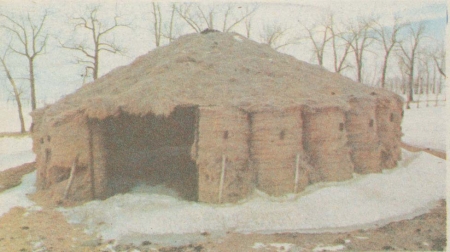
After four years of observation on North Dakota farms, straw bale barns are earning high marks for durability and all-around performance, depending on straw type, building use, protection and weather.
Weathering seems to be minimal. Tightly packed flax bales tied with plastic twine have proved most durable.
Charged electric fence wires attached by insulators are effective in keeping livestock away. Better yet are strong, moveable gates.
So far, no straw buildings have burned, even though operators have used tractors to clean or do inside repair.
Here's a look at several straw barns now in use throughout North Dakota:
Merwin Larsen, Flaxton: He constructed a round barn for dairy heifers with round flax straw bales in 1987. Rafters were made from two used oilfield drillstem pipes (2.8 in. dia. by 31 ft. long) welded into an A-frame. The 6 ft. wide rafter base rests atop the wall. The point is attached to an anchor ring at the top of the center pole.
The barn is
44 ft. across, with 12-ft. high walls. A woven wire inside liner is tied
through the bales to outside wire bands.
Larson says the building is not only the warmest one on his farm in winter, but the coolest in summer.
Rodney Brandt, Maxbass: Rodney, one of the first livestock producers to try straw bale barns, built a 30 by 60 by 12-ft. structure in 1984. It still functions as a cattle shelter. His newest building is a 30 by 40-ft. pole straw barn. Poles are spaced 10 ft. off center in the walls and 15 ft. through the center to support oilfield drillstem pipe rafters (2.375 in. dia.) 5 ft. apart.
Brandt, who has four straw barns still in use, has tried different straw types. He feels flax straw is the best.
Greg
Ankenbauer, Kenmare: He used conventional (18 by 18 in. by 3 ft.) flax straw
bales set on edge to build cow-calf barns at two ranches in 1987. The 40-ft.
wide barns have roof supports poles 8 ft. off center that support 2.8 in. dia.
oilfield drill-stem pipe rafters. No. 9 ga. reinforced mesh wire was used in
the roof and over the walls.
Alvis Beaver, Rolette: Alvis made a 28 by 84 by 12 ft. barn for 65 sows out of cattail-sloughgrass-kochia bales in the fall of 1988. The barn is centered over an automatic waterer divider to serve four pens. Each pen has a small doorway to an outside feedyard.
Alvis spaced used 35-ft. electric poles 3 ft. apart for rafters. They rest on a 2 by 10-in. plate atop the walls.
Pigs preferred the cattail bales.
Arden Moline, Rugby: He notes that sheep ate through and over a snow fence in a 32 by 48-ft. barn he made of 6 by 4-ft. round bales.
He stretched woven wire and stapled it to electric pole rafters spaced from 4 to 6 ft. apart.
Straw-barn owners report that disease, bird and rodent problems in straw barns are similar to conventional buildings containing feed, bedding and insulation.
(Reprinted from The Farmer magazine)
The author is professor emeritus at North Dakota State University. While there is no formal research project at NDSU, straw bale buildings will continue to be monitored informally to determine optimum roof slope, construction design, straw type, bale protection and rafter design. Dexter would like to hear from FARM SHOW readers who have had experience with straw-bale buildings.
